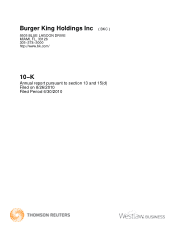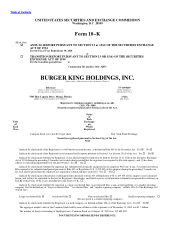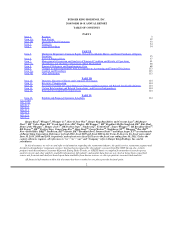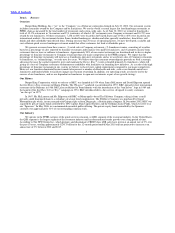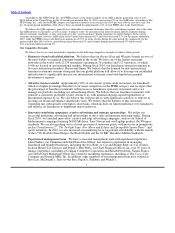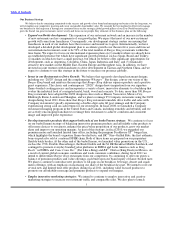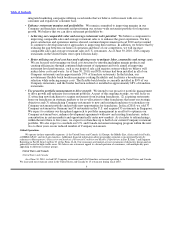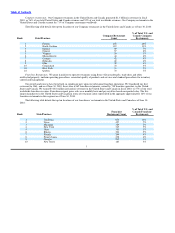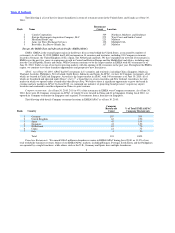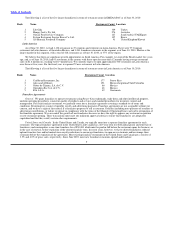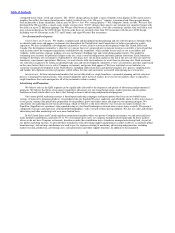Burger King 2010 Annual Report Download - page 6
Download and view the complete annual report
Please find page 6 of the 2010 Burger King annual report below. You can navigate through the pages in the report by either clicking on the pages listed below, or by using the keyword search tool below to find specific information within the annual report.
Table of Contents
According to The NPD Group, Inc., the FFHR category is the largest category in the QSR segment, generating sales of over
$62.6 billion in the United States for the 12−month period ended May 30, 2010, representing 27% of total QSR sales. According to The
NPD Group, Inc., sales for the FFHR category are expected to increase at an average rate of 5% per year over the next five years. For
the 12−month period ended May 2010, Burger King accounted for approximately 14% of total FFHR sales in the United States.
We believe the QSR segment is generally less vulnerable to economic downturns than the casual dining segment, due to the value
that QSRs deliver to consumers, as well as some “trading to value” by customers from other restaurant industry segments during
adverse economic conditions, as they seek to preserve the “away from home” dining experience on tighter budgets. In the current
economic environment, however, QSR traffic in the United States decreased 1% and sales decreased 0.5% for the quarter ended May
2010, while the FFHR category declined at an annual rate of 0.5% in terms of sales during the same period. By comparison, for the
quarter ended May 2010 visits to casual dining chains decreased 3% and to family dining chains decreased 3% while overall
U.S. restaurant traffic decreased 1%.
Our Competitive Strengths
We believe that we are well−positioned to capitalize on the following competitive strengths to achieve future growth:
• Distinctive brand with global platform. We believe that our Burger King and Whopper brands are two of
the most widely−recognized consumer brands in the world. We have one of the largest restaurant
networks in the world, with 12,174 restaurants operating in 76 countries and U.S. territories, of which
4,916 are located in our international markets. During fiscal 2010, our franchisees opened restaurants in
two new international markets, Russia and Oman. We believe that the demand for new international
franchise restaurants remains strong and that our global platform will allow us to leverage our established
infrastructure to significantly increase our international restaurant count with limited incremental
investment or expense.
• Attractive business model. Approximately 90% of our current system−wide restaurants are franchised,
which is a higher percentage than that of our major competitors in the FFHR category and we expect that
the percentage of franchise restaurants will increase as franchisees open new restaurants and as we
manage our portfolio, including our refranchising efforts. We believe that our franchise restaurants will
generate a consistent, profitable royalty stream to us, with minimal ongoing capital expenditures or
incremental expense by us. We also believe this will provide us with significant cash flow to reinvest in
growing our brand and enhance shareholder value. We believe that the benefits of this restaurant
ownership mix substantially outweigh its drawbacks, which include our limited influence over franchisees
and reliance on franchisees to implement major initiatives.
• Innovative marketing campaigns, creative advertising and strategic sponsorships. We utilize our
successful marketing, advertising and sponsorships to drive sales and generate restaurant traffic. During
fiscal 2010, we launched innovative, creative and edgy advertising campaigns, such as our School of
Endorsements campaign featuring NASCAR driver Tony Stewart and our flagship product, the Whopper
sandwich. We are also reaching out to a broad spectrum of restaurant guests with movie tie in promotions,
such as Transformers 2tm, The Twilight Saga: New Moon and Eclipse and SpongeBob SquarePantstm and
sports initiatives. In 2010, we also increased our marketing focus on extreme affordability with the launch
of the 1/4 lb. Double Cheeseburger, the Buck Double and the $1 BK® Breakfast Muffin Sandwich.
• Experienced management team. We have a seasoned management team with significant experience.
John Chidsey, our Chairman and Chief Executive Officer, has extensive experience in managing
franchised and branded businesses, including the Avis Rent−A−Car and Budget Rent−A−Car systems,
Jackson Hewitt Tax Services and PepsiCo. Ben Wells, our Chief Financial Officer, has over 30 years of
finance experience, including at Compaq Computer Corporation and British Petroleum. Natalia Franco,
our Global Chief Marketing Officer, has extensive marketing experience, including at The Coca−Cola
Company and General Mills, Inc. In addition, other members of our management team have worked at
Frito Lay, McDonald’s, Jack−in−the Box, PepsiCo, Pillsbury and Wendy’s.
4

